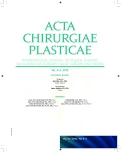A-08 Use of NPWT during reconstructive procedures in plastic surgery
Authors:
J. Ulianko
Authors place of work:
Department of Plastic Surgery, Slovak Medical University Hospital with Policlinics of FD Roosevelt, Banská Bystrica, Slovakia
Published in the journal:
ACTA CHIRURGIAE PLASTICAE, 57, 3-4, 2015, pp. 57-58
Category:
Selected abstracts from the 36th national congress of the czech society plastic surgery with international participation
Introduction
Negative pressure therapy belongs among the newest methods to treat complicated wound healing. It supports granulation, mechanically shrinks the wound edges, removes fluids and reduces quantitative amount of bacteria in wound and reduces swelling. It consists of a contact layer, usually gauze soaked in silver or a silicone sheet, from porous foam or gauze covered with air tight dressing, on which is applied vacuum generated by a machine. Effective pressure is 25–500 mmHg. According to the extent of vacuum, it is possible to divide the technique to high pressure and low pressure. Currently, in most indications, is established the optimal level of vacuum to 125 mmHg. It has been used in plastic surgery, apart from the basic indication, to initiate wound healing, for fixation of free skin grafts and fixation of flaps. In these types of applications are used and recommended low vacuum pressures, 70–90 mmHg in continual mode. For fixation of free skin grafts were established exact indications because under optimal conditions has NPWT fixation no benefit compared with the classical fixation using a gauze bolus. It is important to mention contraindications of vacuum therapy: acute bleeding, wound necrosis, presence of tumor cells in the wound bed, fistulas that were not further investigated and relative contraindication is also infection.
Material and methods
This presentation includes 81 patients with defects of various origin and it presents the benefits of NPWT fixation of skin grafts, statistical evaluation of take, based on the origin of the defect, microbial contamination and localization of the defect. Transplants were 0.25–0.3 mm thin, harvested with an electrodermatomeand meshed manually to approx. 1 cm holes. Defects and healed areas were measured in vivo with a measure gauge at the site of maximal length and width. There was not even one case of complete loss of the transplant. Incomplete healing in 21 cases included 13 in the group with take percentage above 80%. High efficiency of vacuum fixation is demonstrated also in a case report with 100% take in a semicircular calf ulcer, contaminated with MRSA, Pseudomonas aeruginosa and E. Coli. In the examples of case reports is demonstrated the use and benefits of NPWT in plastic surgery on fixation of flaps and stimulation of healing. In these cases, it is important to use lower vacuum level and place the disc outside of the flap pedicle, as a prevention of ischemia. Negative pressure in that case has a favorable effect on venous congestion of the flap, it reliably fixes the flap without ischemia and last but not least contributes on management of exudate. Barrier function acts as prevention of infection.
Conclusion
Use of NPWT in plastic surgery includes use for fixation of a skin graft, flaps and stimulation of wound healing. It protects the wound, keeps moisture and prevents external effects, prepares the wound for secondary surgical intervention by improving the quality of wound bed, by reducing its size and enables usage of less demanding reconstructive method from the reconstructive ladder. Vacuum fixation of meshed skin grafts seems to be an advantageous fixation method in patients with defects of various origin under non-optimal conditions, such as non-homogeneous bed, poor perfusion, poor granulation tissue, increased discharge from the defect, increased contamination of the defect, stable fixation that cannot be achieved otherwise and extensive areas. It increases the percentage of graft take and shortens the time needed for fixation of the graft and also duration of hospitalization of the patients. It also enables an earlier mobilization and rehabilitation of the patients. During the use for flap fixation, it provides reliable fixation without ischemia and it has a beneficial effect on venous congestion of flaps.
Zdroje
1. Birke-Sorensen H et al.Evidence-based recommendations for negative pressure wound therapy: treatment variables (pressure levels, wound filler and contact layer)-steps towards an international consensus. J Plast Reconstr Aesthet Surg. 2011 Sep;64 Suppl:S1–16.
2. Llanos S, Danilla S, Barraza C, Armijo E, Piñeros JL, Quintas M, Searle S, Calderon W.Effectiveness of negative pressure closure in the integration of split thickness skin grafts: a randomized, double-masked, controlled trial. Ann Surg. 2006 Nov;244(5):700–5.
3. Bischoff M, Maier D, Sarkar M, Halter G, Beck A. Vacuum-sealing fixation of mesh grafts. European Journal of Plastic Surgery, July 2003, Volume 26, Issue 4, pp 186–190.
Štítky
Chirurgie plastická Ortopedie Popáleninová medicína TraumatologieČlánek vyšel v časopise
Acta chirurgiae plasticae

2015 Číslo 3-4
- Metamizol jako analgetikum první volby: kdy, pro koho, jak a proč?
- MUDr. Lenka Klimešová: Multioborová vizita může být klíčem k efektivnější perioperační léčbě chronické bolesti
- Léčba akutní pooperační bolesti z pohledu ortopeda
- Příčiny a možnosti ovlivnění bolesti předního kolene po implantaci totální endoprotézy
Nejčtenější v tomto čísle
- 36th NATIONAL CONGRESS OF THE CZECH SOCIETY OF PLASTIC SURGERY WITH INTERNATIONAL PARTICIPATION
-
ZORA JANŽEKOVIČ
(September 30, 1918 – March 17, 2015) - Dorzoradiální lalok z předloktí v kombinaci se silikonovým spacerem při rekonstrukci kombinovaného devastačního poranění palce – kazuistika
- Editorial
